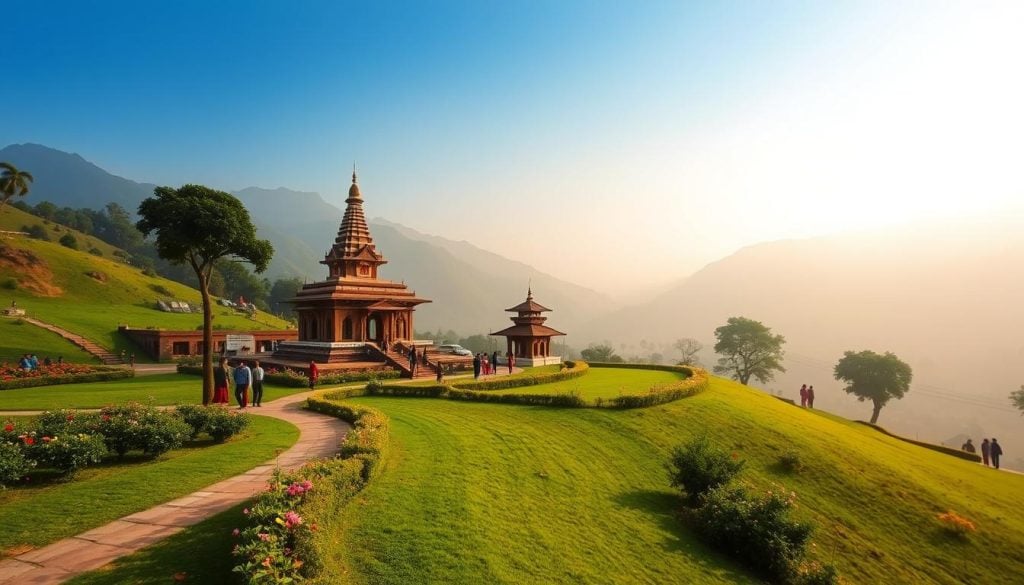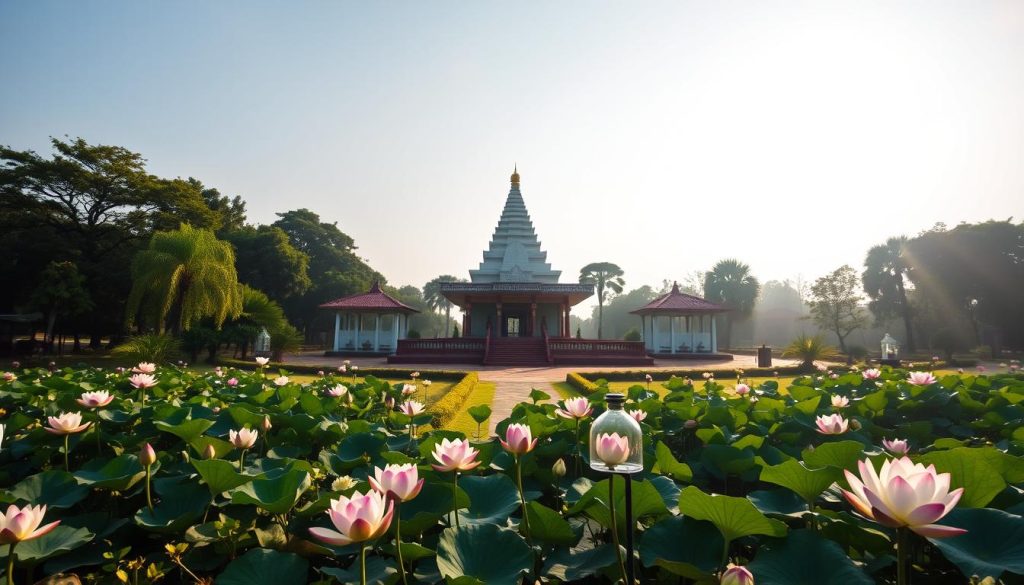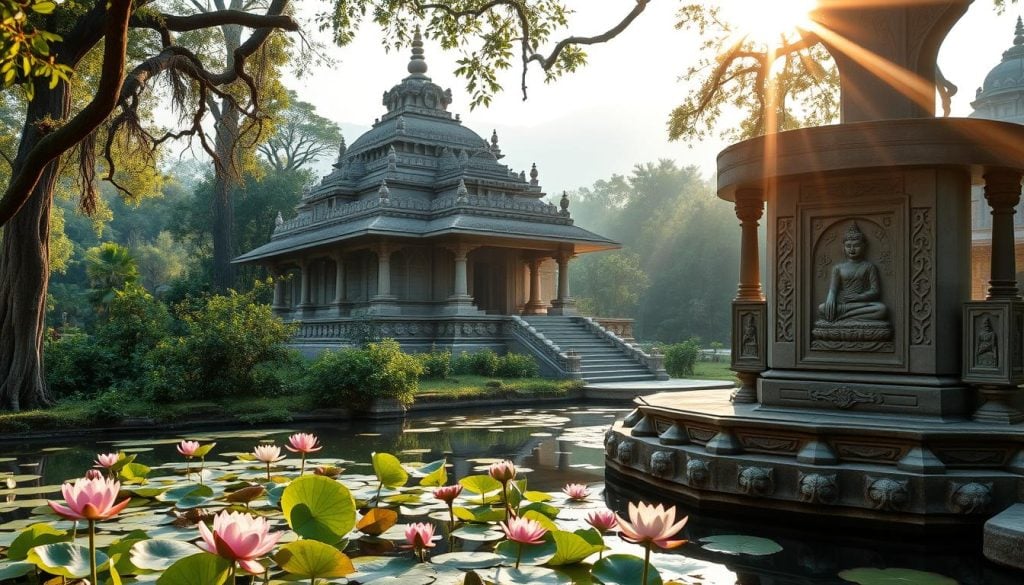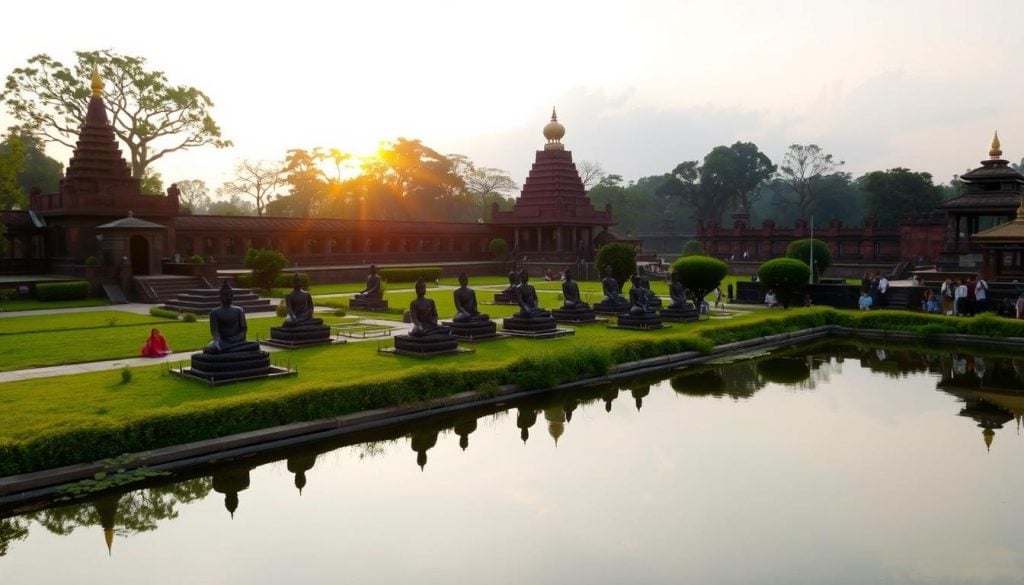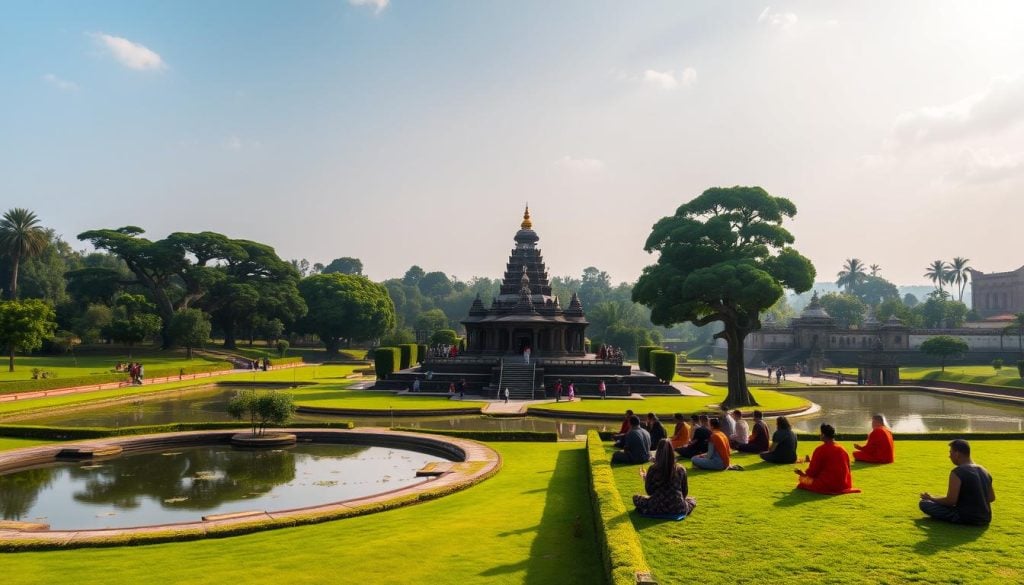Ever wondered why Lumbini, Buddha’s birthplace, is so spiritually significant to millions? As you explore Lumbini’s sacred lands, you’ll learn about its deep spiritual meaning. This article will guide you through its history, cultural sites, and the lasting spiritual connections it offers.
Let’s dive into the spiritual richness of Lumbini. Here, the past and present meet, creating a special journey for all who visit.
The Sacred Birthplace of Buddha
Lumbini is a special place in Buddhist history. It’s where Buddha was born, and it holds a deep meaning for many. The Lumbini significance explanation talks about its history and its role in spiritual journeys.
Historical Context of Lumbini
This sacred site is in southern Nepal and is a UNESCO World Heritage Site. It has the Ashokan Pillar, built in the 3rd century BCE by Emperor Ashoka. The Maya Devi Temple is also there, with a stone marking Buddha’s birth. This shows Lumbini’s Lumbini religious significance as the start of Buddhism.
Importance for Buddhist Pilgrims
Lumbini is one of the four sacred sites Buddha recommended. It attracts many pilgrims looking for enlightenment. Visitors come all year to follow Buddha’s path and learn from his teachings. This journey connects them deeply to Buddhism, making Lumbini a key place for followers.
What is the spiritual significance of Lumbini?
Lumbini is where Buddha was born, making it a place of deep spiritual meaning. It invites people to learn about Buddha’s life and teachings. Every part of Lumbini, from its calm setting to its historical sites, helps us understand its spiritual value.
Connection to Buddha’s Life and Teachings
Lumbini is closely tied to Buddha’s journey. It’s where his spiritual path began, leading to enlightenment. Here, you can think about Buddha’s teachings on letting go and kindness. These lessons help deepen your understanding of Lumbini’s spiritual side.
Exploring the Serene Atmosphere
Walking through the Sacred Garden, you find a peaceful place for thinking and meditation. This calm setting helps you connect with yourself and Buddhism’s teachings. Many find Lumbini’s energy sparks deep reflection, making it a special journey. The mix of nature and history makes Lumbini a place of spiritual growth.
Key Spiritual and Cultural Attractions
Lumbini is a place of deep history and spirituality. It’s famous for the Maya Devi Temple and the Ashokan Pillar. These sites show the spiritual and cultural importance of Lumbini. They help us understand Buddhism’s big impact on this area.
Maya Devi Temple and Its Symbolism
The Maya Devi Temple is a key spot in Lumbini. It marks where Siddhartha Gautama, the Buddha, was born. This temple is very important for those who visit.
Inside, you’ll find a stone marker that shows where the Buddha was born. The temple’s design is simple but beautiful. It reflects the values of peace and thoughtfulness. The temple is alive with rituals and spiritual activities, showing the sacred meaning of Lumbini.
Ashokan Pillar: A Monument of Reverence
Next to the Maya Devi Temple is the Ashokan Pillar. It was built in the 3rd century BCE by Emperor Ashoka. This pillar shows how Buddhism spread far and wide.
The inscriptions on the pillar tell us about the connection between Ashoka and Buddha’s teachings. Standing by this pillar, you can feel the deep respect for Buddhism. It connects you to the spiritual journey of Buddhism.
| Attraction | Significance | Historical Context |
|---|---|---|
| Maya Devi Temple | Birthplace of Buddha | Built in the 3rd century BCE, significant to Buddhist pilgrimage |
| Ashokan Pillar | Symbol of Buddhism’s Spread | Installed by Emperor Ashoka to honor Buddha’s teachings |
The Lumbini Master Plan
The Lumbini Master Plan is a key example of how architecture meets spiritual importance. It was created by Japanese architect Kenzo Tange in 1978. The plan combines Buddhist philosophy with design to improve the visitor’s journey. It shows a clear Lumbini spiritual interpretation, aiming to educate and inspire.
Architectural Significance by Kenzo Tange
Kenzo Tange mixed modern architecture with Buddhist design in the Master Plan. His work creates a peaceful space where visitors can connect with spirituality. Each area has its purpose, helping you understand Buddha’s teachings.
Spatial Organization and Spiritual Path
Lumbini’s layout is both thoughtful and enlightening. It has zones for everyday activities, learning, and enlightenment. This setup highlights the site’s importance and lets you start a meaningful journey.
As you walk through, the calm environment invites reflection. It shows the deep impact of Buddha’s teachings.
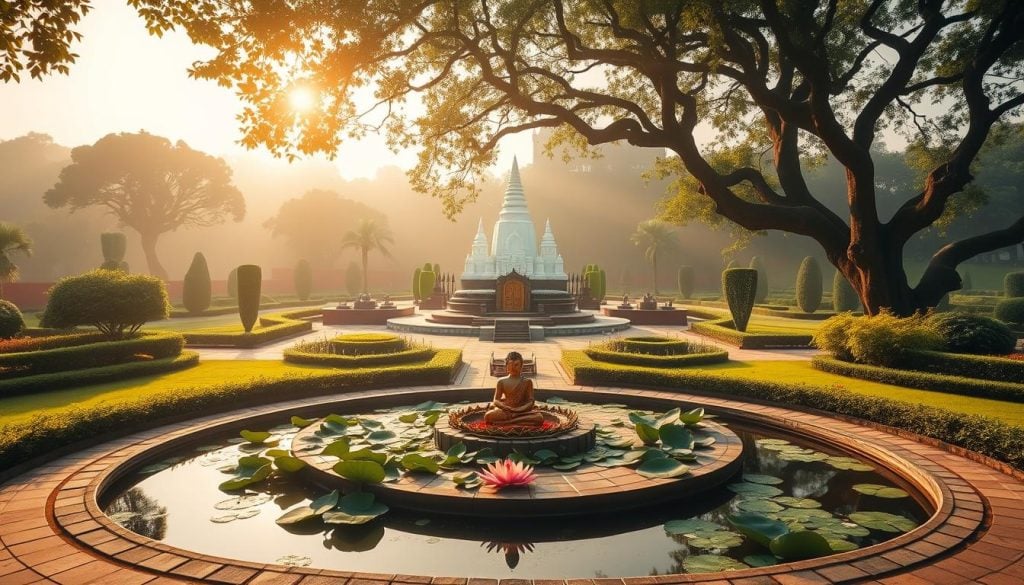
Understanding Lumbini’s Spiritual Importance
Lumbini is a sacred place in Buddhism. It’s where people come to learn about Buddhism’s core beliefs. The site is known for its role in meditation and spiritual growth.
The gardens and ancient monuments create a peaceful space for spiritual practice. Visiting Lumbini lets you dive into Buddha’s teachings. It’s a chance to connect with a rich spiritual tradition.
Lumbini also supports dialogue among different faiths. It brings together various spiritual traditions. This mix promotes compassion, mindfulness, and community, values shared by Buddhism and other faiths.
Exploring Nearby Sacred Sites
As you explore Buddhist history, nearby sites deepen your understanding. Each place adds something special to the Lumbini spiritual story. You get to see key moments in Buddha’s life in these amazing places.
Kudan: The Site of Buddha’s Enlightenment Encounter
Kudan is important because it marks Buddha’s first meeting with his father after enlightenment. It’s a place filled with deep emotions, with stupas that tell the story of his journey. It’s a quiet spot for thinking and learning about Lumbini.
Devadaha: The Maternal Home of Buddha
Devadaha is where Buddha grew up, giving insight into his early life. It lets visitors feel the history of his family. Understanding his upbringing helps us see who Buddha was and what he taught.

| Site | Significance | Key Features |
|---|---|---|
| Kudan | First Encounter with Father | Stupas commemorating Buddha’s enlightenment |
| Devadaha | Maternal Home | Insights into Buddha’s family background |
Experiencing the Pilgrimage Journey
Going on a pilgrimage to Lumbini is a deep dive into history and spirituality. With careful planning, you can connect more deeply with its rich heritage.
Planning Your Visit and Itinerary Suggestions
Make sure your trip includes the main sights in Lumbini. Dive into the heart of Lumbini’s sacred meaning at different places. Spend time at:
- Maya Devi Temple to see its importance in Buddha’s birth
- Ashokan Pillar for a moment of reflection on history and faith
- The sacred gardens for meditation and self-reflection
Local Cuisine and Cultural Exchanges
Try the local Tharu dishes for a special taste experience. Eating with locals helps you understand Lumbini’s spiritual side. You can also:
- Join local festivals to celebrate Buddha’s teachings
- Go to workshops on meditation and wellness
- Check out markets for handmade crafts and spiritual items
By planning well and getting involved with the community, your journey will be truly meaningful. It will capture the essence of Lumbini’s sacred and spiritual significance.
Lumbini’s Role in Modern Spirituality
Lumbini is a key place for modern spirituality, attracting many visitors from different faiths. It offers a special atmosphere for interfaith dialogues and shared experiences. Here, you can deeply connect with Buddha’s teachings through understanding and compassion.
Diverse Visitors and Interfaith Experiences
Exploring Lumbini reveals its spiritual importance. People from all walks of life come together, celebrating its mystical significance. This place encourages reflection on universal values like empathy and enlightenment.
- Visitors engage in meaningful conversations about spirituality.
- Shared rituals between different cultures promote harmony.
- Workshops on meditation and mindfulness attract various faiths.
The spirit of collaboration at Lumbini creates a rich mix of interfaith interactions. By joining exchange programs and community activities, you see the power of diverse spiritual views. This not only helps personal growth but also brings people together, showing the Buddha’s teachings of compassion and enlightenment.
| Spiritual Practice | Religious Backgrounds | Common Values |
|---|---|---|
| Meditation | Buddhism, Hinduism, Christianity | Peace, Mindfulness |
| Ritual Ceremonies | Jainism, Islam, Indigenous Traditions | Harmony, Respect |
| Community Service | Various Faiths | Compassion, Cooperation |
In the end, Lumbini is a spiritual haven where traditions come together. It enriches your understanding of compassion and enlightenment in today’s world.
Conclusion
Lumbini is a remarkable place that shows the deep spiritual roots of Buddhism. People from all over the world visit to find spiritual enlightenment and learn about its culture. By coming here, you join a global community that honors Buddha and his teachings.
At Lumbini, you can think about your own beliefs and see the bigger picture of spirituality. It’s not just a trip; it’s a chance to talk about spirituality, tradition, and respect for each other.
Your visit to Lumbini shows how we’re all connected in our search for spiritual growth. Walking through this historic site, you’ll learn from its teachings and traditions. Sharing your experiences with others, you’ll understand why Lumbini is a key spiritual place in our world today.


































